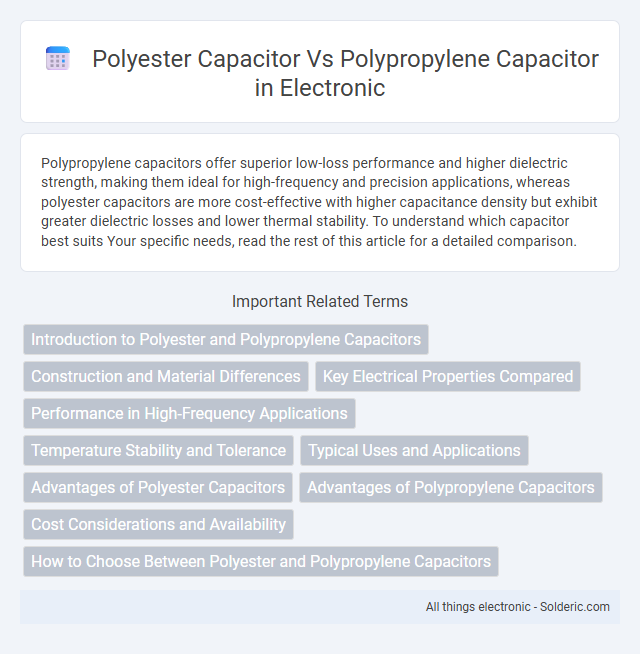Polypropylene capacitors offer superior low-loss performance and higher dielectric strength, making them ideal for high-frequency and precision applications, whereas polyester capacitors are more cost-effective with higher capacitance density but exhibit greater dielectric losses and lower thermal stability. To understand which capacitor best suits Your specific needs, read the rest of this article for a detailed comparison.
Comparison Table
| Feature | Polyester Capacitor | Polypropylene Capacitor |
|---|---|---|
| Dielectric Material | Polyethylene Terephthalate (PET) | Polypropylene (PP) |
| Dielectric Constant | ~3.2 | ~2.2 |
| Operating Temperature Range | -55degC to 105degC | -55degC to 105degC (some up to 125degC) |
| Capacitance Stability | Moderate | High |
| Dielectric Loss (Dissipation Factor) | Higher (0.02 to 0.05) | Low (0.0002 to 0.001) |
| Voltage Rating | Low to Medium (typically up to 100V) | Medium to High (up to 630V and higher) |
| Applications | General-purpose, coupling, bypass, filtering | Precision circuits, audio, RF, timing, high-frequency use |
| Cost | Lower cost | Higher cost |
| Humidity Resistance | Moderate | Excellent |
| Lifetime | Shorter | Longer |
Introduction to Polyester and Polypropylene Capacitors
Polyester capacitors utilize a polyethylene terephthalate (PET) dielectric, offering moderate stability and cost-effectiveness, commonly used in general purpose applications. Polypropylene capacitors feature a polypropylene dielectric, known for superior electrical properties such as low dielectric loss, high insulation resistance, and excellent frequency response, making them ideal for precision and high-frequency circuits. The choice between polyester and polypropylene capacitors depends on factors like temperature stability, dielectric absorption, and application-specific electrical requirements.
Construction and Material Differences
Polyester capacitors use polyethylene terephthalate film as their dielectric material, characterized by moderate dielectric constant and good mechanical strength but higher dielectric losses compared to polypropylene capacitors. Polypropylene capacitors employ polypropylene film, which offers superior electrical properties such as low dielectric absorption, low loss, and high insulation resistance, making them ideal for high-frequency and precision applications. Understanding these construction and material differences helps you select the appropriate capacitor based on required performance, temperature stability, and reliability.
Key Electrical Properties Compared
Polypropylene capacitors exhibit lower dielectric loss and higher insulation resistance compared to polyester capacitors, making them ideal for high-frequency and precision applications. Polyester capacitors generally have higher dielectric constant, allowing smaller sizes for the same capacitance but at the cost of increased dissipation factor and reduced stability. Both types differ significantly in voltage rating and temperature tolerance, with polypropylene capacitors offering superior performance under high voltage and temperature extremes.
Performance in High-Frequency Applications
Polypropylene capacitors outperform polyester capacitors in high-frequency applications due to their lower dielectric loss and superior insulation resistance. The stable dielectric properties of polypropylene minimize signal distortion and energy dissipation at frequencies above 100 kHz. Polyester capacitors exhibit higher dielectric absorption and loss, making them less suitable for precise or high-frequency electronic circuits.
Temperature Stability and Tolerance
Polypropylene capacitors exhibit superior temperature stability with minimal capacitance variation across a wide temperature range, typically from -55degC to 105degC, compared to polyester capacitors that show larger fluctuations and less reliability beyond 85degC. The tolerance of polypropylene capacitors is generally tighter, often within +-5%, making them ideal for precision applications, whereas polyester capacitors usually have broader tolerance ranges around +-10% to +-20%. Your choice between the two should consider the operating environment's temperature demands and the required accuracy in capacitance.
Typical Uses and Applications
Polyester capacitors are commonly used in general-purpose electronic circuits such as timing, coupling, and decoupling applications due to their affordability and moderate electrical characteristics. Polypropylene capacitors excel in precision applications like audio circuits, power factor correction, and high-frequency filtering because of their low dielectric loss and high stability under temperature variations. Your choice between polyester and polypropylene capacitors depends on the required tolerance, temperature range, and frequency performance of your specific application.
Advantages of Polyester Capacitors
Polyester capacitors offer superior mechanical strength and better moisture resistance compared to polypropylene capacitors, making them highly reliable in various environmental conditions. Their higher dielectric constant enables smaller capacitance sizes and cost-effective production for compact electronic devices. These capacitors also provide excellent temperature stability up to around 125degC, ensuring consistent performance across a wide operating range.
Advantages of Polypropylene Capacitors
Polypropylene capacitors offer superior electrical performance with lower dielectric losses and higher insulation resistance compared to polyester capacitors. Their excellent stability under temperature variations and long-term reliability make them ideal for precision applications. You will benefit from enhanced efficiency and durability in circuits requiring low signal distortion and high-frequency response.
Cost Considerations and Availability
Polyester capacitors are generally more cost-effective than polypropylene capacitors due to lower raw material and manufacturing expenses, making them widely available for mass-market applications. Polypropylene capacitors, while more expensive, offer superior electrical performance and stability but have limited availability and higher lead times because of specialized production processes. The choice between the two often depends on balancing budget constraints with performance requirements and supply chain considerations.
How to Choose Between Polyester and Polypropylene Capacitors
Selecting between polyester and polypropylene capacitors depends on application requirements such as dielectric stability, frequency response, and temperature tolerance. Polypropylene capacitors offer superior electrical properties with low dielectric loss and high insulation resistance, making them ideal for high-frequency circuits and precision filtering. Polyester capacitors are more cost-effective and provide good physical durability, suitable for general-purpose applications where performance demands are moderate.
polyester capacitor vs polypropylene capacitor Infographic

 solderic.com
solderic.com